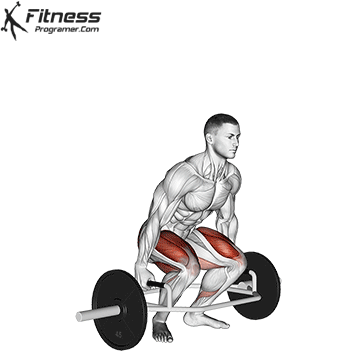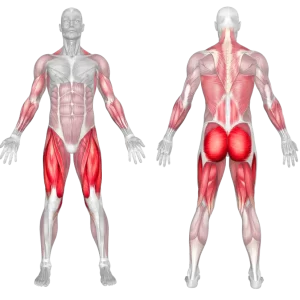Trap Bar Deadlift
The trap bar deadlift (TBDL), also known as the hex bar deadlift, is a popular strength training exercise that primarily targets the muscles in your lower body, including the quadriceps, hamstrings, glutes, and lower back. It also engages the upper body muscles, particularly the trapezius, forearms, and grip strength.
How to do:

Trap bar: This is a hexagonal-shaped barbell with handles on each side. It allows you to stand inside the bar rather than in front of it, which can be more comfortable and provide a more natural lifting motion.
- Set Up:
- Position the trap bar on the ground and load it with the desired weight plates.
- Step inside the trap bar so that you’re standing in the center, with the handles on either side of you.
- Your feet should be hip-width apart, and your toes should be pointing forward or slightly outward.
- Grip:
- Bend at your hips and knees to lower your body down. Keep your back straight and chest up.
- Reach down and grip the handles of the trap bar with both hands, ensuring that your palms are facing each other.
- Your hands should be positioned roughly at hip level or slightly lower.
- Lift:
- Brace your core to maintain a stable spine.
- Push through your heels and stand up, extending your hips and knees simultaneously. Keep your back flat and avoid rounding it.
- As you lift the trap bar, keep it close to your body. Your arms should hang straight down from your shoulders.
- Stand fully upright with your hips and knees locked out, maintaining a neutral spine.
- Lower:
- To lower the trap bar, reverse the motion. Push your hips back first, and then bend your knees.
- Lower the bar gently to the ground, ensuring that it doesn’t crash or bounce.
- Repeat:
- Perform the desired number of repetitions for your workout.
Trap Bar Benefits
- Full-Body Strength: The trap bar deadlift is a compound exercise that engages multiple muscle groups simultaneously, including the legs, lower back, upper back, and grip. It helps develop overall strength and power.
- Lower Body Development: It primarily targets the quadriceps, hamstrings, and glutes, leading to improved lower body strength and muscle development. This can be especially beneficial for athletes involved in sports that require explosive leg power.
- Reduced Risk of Lower Back Injury: Unlike the conventional barbell deadlift, which involves a bent-over position, the trap bar deadlift allows for a more upright posture. This reduces the stress on the lower back, making it a safer option for those with lower back issues or a history of back injuries.
- Increased Grip Strength: Holding the handles of the trap bar challenges your grip strength and forearm muscles. Over time, this can lead to improved grip strength, which can be valuable for various daily activities and sports.
- Improved Posture and Core Stability: The trap bar deadlift encourages proper posture and core engagement, promoting better spinal alignment and reducing the risk of injury.
- Enhanced Athletic Performance: Many athletes incorporate trap bar deadlifts into their training routines because they mimic movements used in sports like basketball, football, and track and field. The exercise can improve overall athletic performance by increasing explosiveness, agility, and power.
- Muscle Hypertrophy: When performed with appropriate weight and repetitions, the trap bar deadlift can stimulate muscle growth, particularly in the legs, lower back, and traps.
- Functional Strength: The strength developed through trap bar deadlifts can have practical applications in daily life, such as lifting heavy objects and performing physical tasks with greater ease and safety.
- Versatility: Trap bar deadlifts can be adapted to various fitness goals. You can use different rep ranges and weights to focus on strength, endurance, or hypertrophy, making them suitable for a wide range of training programs.
- Beginner-Friendly: The trap bar deadlift is often considered more accessible for beginners or those new to weightlifting because it allows for a more natural lifting posture and reduces the learning curve associated with traditional barbell deadlifts.
Trap Bar Muscles Worked
For example, you can emphasize your quadriceps by using a more upright torso position or place more emphasis on your posterior chain (hamstrings and glutes) by leaning forward slightly during the lift. Here are the primary muscles worked during the trap bar deadlift:

